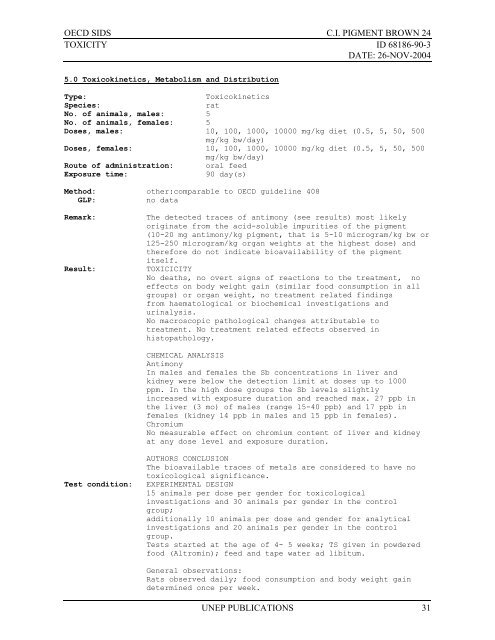C.I. Pigment Brown 24 CAS N°: 68186-90-3
C.I. Pigment Brown 24 CAS N°: 68186-90-3
C.I. Pigment Brown 24 CAS N°: 68186-90-3
Create successful ePaper yourself
Turn your PDF publications into a flip-book with our unique Google optimized e-Paper software.
OECD SIDS C.I. PIGMENT BROWN <strong>24</strong><br />
TOXICITY ID <strong>68186</strong>-<strong>90</strong>-3<br />
DATE: 26-NOV-2004<br />
5.0 Toxicokinetics, Metabolism and Distribution<br />
Type:<br />
Toxicokinetics<br />
Species:<br />
rat<br />
No. of animals, males: 5<br />
No. of animals, females: 5<br />
Doses, males: 10, 100, 1000, 10000 mg/kg diet (0.5, 5, 50, 500<br />
mg/kg bw/day)<br />
Doses, females: 10, 100, 1000, 10000 mg/kg diet (0.5, 5, 50, 500<br />
mg/kg bw/day)<br />
Route of administration: oral feed<br />
Exposure time:<br />
<strong>90</strong> day(s)<br />
Method: other:comparable to OECD guideline 408<br />
GLP:<br />
no data<br />
Remark:<br />
Result:<br />
The detected traces of antimony (see results) most likely<br />
originate from the acid-soluble impurities of the pigment<br />
(10-20 mg antimony/kg pigment, that is 5-10 microgram/kg bw or<br />
125-250 microgram/kg organ weights at the highest dose) and<br />
therefore do not indicate bioavailability of the pigment<br />
itself.<br />
TOXICICITY<br />
No deaths, no overt signs of reactions to the treatment, no<br />
effects on body weight gain (similar food consumption in all<br />
groups) or organ weight, no treatment related findings<br />
from haematological or biochemical investigations and<br />
urinalysis.<br />
No macroscopic pathological changes attributable to<br />
treatment. No treatment related effects observed in<br />
histopathology.<br />
CHEMICAL ANALYSIS<br />
Antimony<br />
In males and females the Sb concentrations in liver and<br />
kidney were below the detection limit at doses up to 1000<br />
ppm. In the high dose groups the Sb levels slightly<br />
increased with exposure duration and reached max. 27 ppb in<br />
the liver (3 mo) of males (range 15-40 ppb) and 17 ppb in<br />
females (kidney 14 ppb in males and 15 ppb in females).<br />
Chromium<br />
No measurable effect on chromium content of liver and kidney<br />
at any dose level and exposure duration.<br />
Test condition:<br />
AUTHORS CONCLUSION<br />
The bioavailable traces of metals are considered to have no<br />
toxicological significance.<br />
EXPERIMENTAL DESIGN<br />
15 animals per dose per gender for toxicological<br />
investigations and 30 animals per gender in the control<br />
group;<br />
additionally 10 animals per dose and gender for analytical<br />
investigations and 20 animals per gender in the control<br />
group.<br />
Tests started at the age of 4- 5 weeks; TS given in powdered<br />
food (Altromin); feed and tape water ad libitum.<br />
General observations:<br />
Rats observed daily; food consumption and body weight gain<br />
determined once per week.<br />
UNEP PUBLICATIONS 31

















